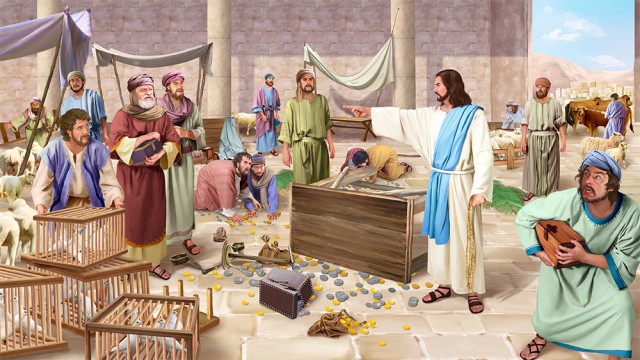In Matthew 21:12-17, we see an account of Jesus entering the temple in Jerusalem and becoming angered by the commercial activities and money-changing taking place within its walls. He proceeds to drive out the merchants and money-changers, overturning their tables and declaring that the temple should be a house of prayer, not a den of thieves.
This event, known as the "Cleansing of the Temple," has been interpreted in a number of ways by scholars and theologians. One possible interpretation is that Jesus was protesting the corruption and commercialization of the temple and religious practices of his time. The temple had become a place where people were more focused on making money and conducting business than on worshiping God. In contrast, Jesus believed that the temple should be a place of reverence and devotion, where people could come to connect with God and offer prayers and sacrifices.
Another interpretation of this event is that Jesus was challenging the religious leaders of his time, who had become more interested in maintaining their power and status than in serving the people. The money-changers and merchants in the temple were likely paying bribes to the priests and other religious officials in order to conduct their business there, and Jesus' actions may have been a way of calling attention to this corruption and challenging the religious leaders to reform their ways.
Additionally, this event can also be understood in light of the prophetic tradition of Israel, in which the temple is seen as the center of God's presence on earth. Throughout the Hebrew Bible, the temple is repeatedly depicted as a place where God's glory dwells and where his people come to worship and offer sacrifices. By cleansing the temple, Jesus is fulfilling this prophetic tradition and asserting his authority as the one in whom God's presence dwells.
Moreover, the cleansing of the temple is also a foreshadowing of Jesus' ultimate sacrifice on the cross. The temple was the place where the Israelites went to make atonement for their sins through the offering of sacrifices, but Jesus' death on the cross would become the ultimate sacrifice for the sins of all people. Thus, the cleansing of the temple can also be understood as a sign of Jesus' mission to bring about a new, more profound way of atoning for sins.
In conclusion, the cleansing of the temple event in Matthew 21:12-17 can be interpreted in several ways. It can be seen as a protest against the commercialization and corruption of religious practices, a challenge to the religious leaders of Jesus' time, a fulfillment of the prophetic tradition of Israel, and a foreshadowing of Jesus' ultimate sacrifice on the cross. It teaches us that the true purpose of religion is to connect with God and to serve others, rather than to use it for personal gain. It also reminds us that Jesus is the one in whom the presence of God dwells and that his ultimate sacrifice is the means by which we are able to receive forgiveness and salvation.

ConversionConversion EmoticonEmoticon